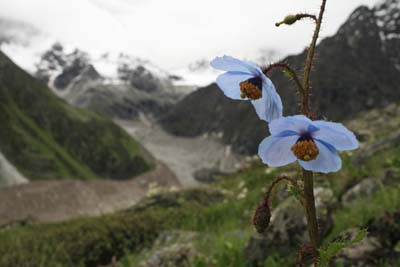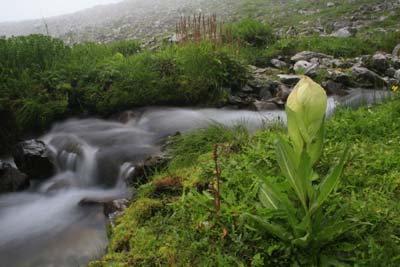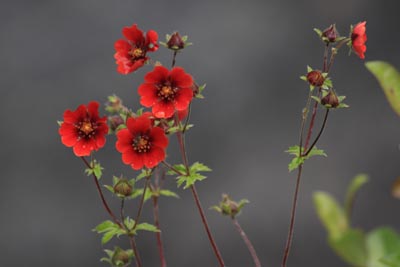BLUE POPPY
Himalayan Blue Poppy the flowers are often called as QUEEN OF HIMALAYAN FLOWERS.The medicinal use of this plant in Uttrakhand is not So common ...
Valley of Flowers National Park - UNESCO World Heritage Site. Officially, Frank Smythe is credited with discovering the Valley of Flowers in 1931, but in some circles it is believed that Richard Holdsworth, a botanist member of Smythe’s successful Kamet Expedition was the real discoverer of the Valley. Smythe got the information from him and went to see and work on it. Of course, the local people had always known about the Valley, but they would rarely venture into it because of a prevailing superstition that the valley was the abode of fairies and anyone venturing into it alone would be taken away by them.
Frank Smythe camped in the valley for one month to collect material for his book” The Valley of flowers” and took with him seeds for the Botanical Gardens in Edinburgh, Scotland. In furtherance of Smythe’s work, Joan Margarent Legge went to the Valley in 1939 to study and collect more flowers. She camped there for a few days, and unfortunately lost her life when she slipped from a rock while picking flowers. Later in 1944, her sister visited the Valley and built a small memorial in the shape of a tombstone. As a reminder of the great love she had for the Himalayas, inscribed on her marble tombstone are the following words.

Himalayan Blue Poppy the flowers are often called as QUEEN OF HIMALAYAN FLOWERS.The medicinal use of this plant in Uttrakhand is not So common ...

Local name of this flowers is brahmakamal , kon and kapfu.for the local people it has a scared place in there rituals and costoms. Nandaashtami ...

It is an alpine valley, and has been formed the retreating glaciers whose periodic advances and retreat pulverised hard rocks, ...
Set amidst majestic snow –clad mountains that stand in bold relief against the skyline, the Valley of Flowers is nearly 10 km in length, 2km in width and concave in shape. It is divided along its length by a small river called the Pushpawati and several tiny streams and waterfalls rush down from the glacial deposits to merge with it. The Pushpawati joins the Laxman Ganga, flowing from Hemkund Sahib at Ghangria. This combined stream retains the name Laxman Ganga till it meets Alaknanda at Govind Ghat.
A massive mountain mantled with snow and called Ghoradhungi , blocks the valley at the other end. There is however, a traditional route which passes across a glacial pass at an altitude Valley and eventually leads to Niti, the last Indian village on the border with Tibet.
Entry fee has to be paid for entering in to the Valley of Flowers. The rates as on the date are as under:-
Indian Tourists :- Rs 150/- per head, Foreign Tourists Rs 600/- per head
( India, State- Uttarakhand, Uttarakhand Himalayans, Distric : Chamoli, Nearest town : Ghangharia - Joshimath )
Govind Ghat , which is 270 km from Rishikesh and 20 km from Joshimath, is the motor head for the Valley of Flowers. At Govind Ghat porters and ponies are available for the 15 km trek to Ghangria. The trek begins after crossing Alaknanda by a suspension bridge and then along a mountain path on the right bank of Laxman Ganga. The trek passes through dense vegetation and whispering forests and Laxmanganga always appears to be hurrying down to meet Alaknanda down below. Then at 10th km is the bhyundar village from where a beautiful valley branches to Kagbhushandi. The trek to Valley of Flowers continues along the Laxman Ganga and at 3km from the village, Laxmanganga has to be crossed and then begins the final zig zag climb to Ghangria. Ghangria, nestled amidst the giant deodars, is the halting place for both Hemkund Sahib and the Valley of Flowers. Camping in the valley is not permitted, visitors have to spend the nights at Ghangria only. As the path from Ghangria gradually ascends to the Valley of flowers , glaciers, snow bridges, alpine flowers and wildlife begin to appear along this 4 km trek. At 4 km, one only touches the valley and the colourful patterns lie ahead up to a distance of 10 kms.
| Place | Altitude (m) | Distance (km) |
| Joshimath | 1890 - | - |
| Govind Ghat | 1829 - | 20 motorable |
| Pulna | 1920 - | 3 trek |
| Bhyundar | 2439 - | 7 trek |
| Ghangaria | 3049 - | 5 trek |
| Valley of flowers | 3352 (lowest point) | 4 trek |
| Valley of flowers | 3658 (highest point) | 10 trek |
| Hemkund Lake | 4210 (highest point) | 10 trek |
A massive mountain mantled with snow and called Ghoradhungi , blocks the valley at the other end. There is however, a traditional route which passes across a glacial pass at an altitude Valley and eventually leads to Niti, the last Indian village on the border with Tibet.
A small stream comes down from the glacial mountains and joins Pushpawati. This stream has been named by local enthusiasts as Priyadarshini. The valley along the Priyadarshini stream is a valley within a valley. All along its bank, there are unique flower patterns. The rugged islands formed by the glacial rubbles sporting different colours are a common feature. A walk along this stream keeps visitors guessing whether the beautiful patterns are the result of human effort or whether they are creation of that unseen ONE.
The picturesque area on the left bank of Pushpawati is known as Nag Tal and is home to an extremely poisonous flower. The poisonous flower. This poisonous flower is blue in colour, looks like the domestic dog-flower or antirhynum, and bears the botanical name of Aconitum Balfouri. It is also seen growing in far less abundance on the right bank which is the main valley. The flower is extremely attractive and the visitors have to be careful not to touch or pluck it. Due to the absence of bridge over Laxman Ganga, visitors are unable to cross over to Nag Tal.
I have seen the valley without flowers and also with abundance of flowers and each time the valley looked beautiful as if it is the garden of Gods. During the months of April and May, the glacial deposits melt to make room for the plants to come up. Mid even to mid June the buds start showing and some early varieties even start to bloom. In the lower reaches anemone and premula are the early species to flower. Rhododendron of course is an early flowering tree. Mid June to mid July to third week of August which is the best time to visit, the valley gets bedecked with several colours of flowers. The assorted varities of flowers adorning the valley, and wafting their fragrance around, are a sight to behold. By mid September, the flowers begin to wither and die, but the valley, with its spectacular surroundings mountains still holding the remaining glacial deposits, is still a sight to be seen and admired.
Some of the flowers which can be seen in this garden valley are: Pink Primula, Pedicularis, Golden Lily, creamy Anemones, large purple Asters, the rare white Androsace, the blue Borage, the rosy-petalled Cypripedium, blue-Forgetme-nots, green and chequered Fritillaries, pink Geraniums, purple and dwarf Irises, dwarf Larkspurs, the indigo-coloured Nomocharis, blue and yellow Pansies, mauve Polermomiums, the blue Poppy (Mecanopsis)- petals as blue as the ocean, white and red Potentillas, golden lilly, dwarf Rhododendrons Primulas in pink and blue and deepest purple, Ranunculus, pink Epilobium and the heavily perfumed Brahma Kamal.
Govind Ghat , which is 270 km from Rishikesh and 20 km from Joshimath, is the motor head for the Valley of Flowers. At Govind Ghat porters and ponies are available for the 15 km trek to Ghangria. The trek begins after crossing Alaknanda by a suspension bridge and then along a mountain path on the right bank of Laxman Ganga. The trek passes through dense vegetation and whispering forests and Laxmanganga always appears to be hurrying down to meet Alaknanda down below. Then at 10th km is the bhyundar village from where a beautiful valley branches to Kagbhushandi. The trek to Valley of Flowers continues along the Laxman Ganga and at 3km from the village, Laxmanganga has to be crossed and then begins the final zig zag climb to Ghangria. Ghangria, nestled amidst the giant deodars, is the halting place for both Hemkund Sahib and the Valley of Flowers. Camping in the valley is not permitted, visitors have to spend the nights at Ghangria only. As the path from Ghangria gradually ascends to the Valley of flowers , glaciers, snow bridges, alpine flowers and wildlife begin to appear along this 4 km trek. At 4 km, one only touches the valley and the colourful patterns lie ahead up to a distance of 10 kms.
Like all other National Parks, entry fee has to be paid for entering in to the Valley of Flowers. The rates as on the date are as under:-
This is how in one of his writings, Guru Govind Singh indicated that in one of his previous births he had meditated on the shores of a lake surrounded by seven snow-covered peaks known as Shapta Shring. In 1930, Havildar Sohan Singh was on a mission to locate this celestial lake. He was taken by the local villagers to a lake near the Valley of Flowers, then known as Lokpal. Havildar Sohan Singh was so overwhelmed by the beauty of the lake and the image of snow peaks in the rippling waters, that he immediately shouted “This is the Lake” referred to by Guru Govind Singh.
Seven Snow covered peaks surround Hemkund lake and their reflection in the bluish-green water is a picture to behold.
As Guru Govind Singh is revered equally by the Sikhs and Hindus, this lake has today become a popular pilgrimage centre for both the communities.
The motor head for Sri Hemkund Sahib is Govind Ghat which is located 270 km from Rishikesh and 20 Km from Joshimath. Porters and ponies are available for the 20 km. trek. The trek up to Ghangria (Govind Dham) is the same as for the Valley of Flowers.
Whilst the trek from Ghangria to the Valley of Flowers is a gradual ascent, that to Hemkund Sahib is a steep climb and a pony is necessary for the elderly ones. The route is enchanting and waters of the Laxman Ganga (Hem Ganga) in its many moods, is a constant delight to the trekkers. The Laxman Ganga descends from Hemkund Sahib and joins with the Pushpawati at Gangaria.
The combined stream retains the name Laxman Ganga. One passes by waterfalls and ridges richly caprpeted with flowers. In autumn, the fragrant Brahma Kamal along with Blue Poppy and Bistorta Affinis are seen growing profusely.
My last visit to this area was in 1990. After a rewarding visit to the Vallley of Flowers, I decided to go to the sacred shrine of Sri Hemkund Sahib. It was a pilgrimage combined with the urge of seeing more flowers on the mountains slopes. This was my seventh visit to the shrine and keeping in mind the steep climb and advanced age 59, I engaged a pony for any emergency that might arise. The journey started at seven in the morning with the early rays of dawn having already painted the mountain tops in gold. With everything fresh and fragrant, I could not resist the temptation of walking and the pony master was more than happy to follow. I must have walked more than half the distance when I saw an elderly looking Bengali tourist of almost my age who was left behind by his group due to fatigue. He looked tired and yet determined to reach the shrine. It must have been by the grace of Sri Hemkund Sahib that I some how saw in him a pious soul needing help to reach the holi spot. As an answer to this divine call.
I offered him my pony. Surprised, he first refused the offer and then accepted with gratitude. I continued the trek and never needed the pony again. It was enjoyable trek in the midst of beautiful patterns of flowers, and an absolute sense of satisfaction on the timely help accepted by a needy person. In a land as pure as this the urge of doing good is always spontaneous and this is what makes the mountains so mystic and different from rest of the world.
1. Being monsoon, weather in Ghangharia, Valley of Flowers and Hemkund could be rainy and cold, with temperature ranging from max 20 degrees celsius to min - 10 degrees celsius. It is recommended that clients carry suitable warm clothing, protective gear for rainy season and good shoes
2. Clients are advised to consult their physician and take suitable preventive medication (if prescribed) as a precaution for high altitude sickness
3. Trekking on any particular day may be aborted or cancelled in case of extreme / unfavourable weather conditions, keeping in mind safety of the clients. Himalayan Snow Runner trip leader's decision on this will be final and binding on clients. No refund of costs or any compensation will be paid to clients in such case
4. All clients will have to complete and sign Himalayan Snow Runner's mandatory Client Information and Waiver Form before starting the trek